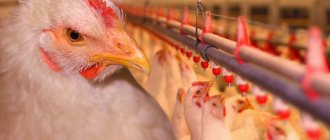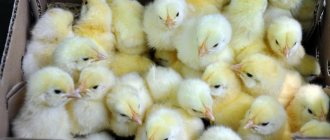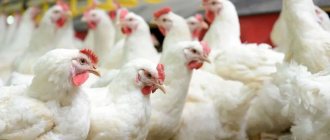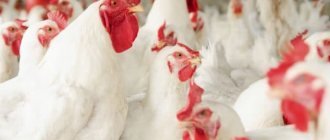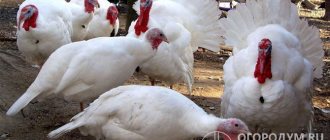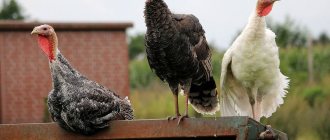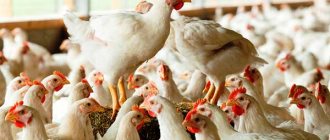For the sake of tasty meat, many owners raise chickens in their gardens. Do broilers lay eggs, is it possible to breed chickens at home - questions that are often asked to experts.
The high demand for dietary chicken meat and the increase in its production on an industrial scale have intensified breeding and genetic work. Its goal is to breed breeds that accumulate only one valuable quality - rapid weight gain, the number of eggs laid, and rapid achievement of maturity.
Broilers, purpose of selection
Breeders working in the field of poultry farming stopped working with pure breeds back in the middle of the 20th century. The main focus of the work was the correction of lines - a group of birds, in the breeding of which the desired trait became the main one.
The line can be based on one or several breeds at once, resulting in a “simple” or “combined” line. The birds resulting from the work are called hybrids. According to the required indicators for an individual, they are much higher than their parents, which is ensured by the best qualities “collected” from different breeds.
Breeders try to combine not only breeds, but also lines, which sometimes gives an unexpected effect. Birds of three or four lines can be used in crossing; the individuals that result are called crosses (the numerical designation in the breed shows the number of lines used in the selection). The bulk of bred crosses are bred on the basis of four.
Broiler chickens are hybrids or crosses obtained by crossing lines and breeds. The goal of selection is to achieve maximum weight gain in the shortest possible time. The main breeds used in Russia are ROSS 308, COBB 500, Hubbard 15 F - there are quite a lot of them, the distinctive features of the breed can often only be distinguished by a specialist.
A feature of such chickens is the later achievement of sexual maturity - the age when chickens begin to lay eggs (birds grow only until puberty).
At what age do chickens start laying eggs?
The most important factor in determining the age at which eggs begin to lay is the choice of crossbreed or breed. The earliest representatives in this regard begin to lay eggs at the age of seventeen to twenty weeks. However, most often it takes about six months to ripen.
It's not all about race. It is important to provide the bird with good housing and care, as well as balanced food.
There are special drugs that can accelerate the maturation of layering. Thanks to them, puberty occurs earlier than expected, but the laying hen in this case is short-lived. In addition, their use may affect the quality of the product and the health of the poultry, so the use of such products is not recommended.
Features of crosses
To breed broilers, meat breeds (Cornish, roosters) and universal breeds (Plymouth rock, chickens) were used. The resulting individuals differ in physiological characteristics:
- later puberty (they start laying eggs later);
- rapid weight gain;
- very large eggs;
- two yolks;
- The most delicious meat comes from birds that have not reached the age of maturity.
The goal of broiler breeding is to obtain the maximum amount of meat. This is achieved by a properly structured diet for birds - appropriate feeding allows them to reach a weight of up to 2000 g already on the 45th day of life. Broilers can be slaughtered at two months of age; the weight of the chicken at this time can exceed 4 kilograms.
The recommendations of experts are clear - a broiler is not suitable for keeping for the purpose of obtaining eggs, although birds can lay eggs; for this, you can select a specialized breed.
Domestic specialists are working on breeding universal meat and egg crosses for breeding at home.
American researchers analyzed the beneficial elements contained in broiler eggs. The results showed that the differences relate only to the size and number of yolks; the content of microelements is identical to that of a regular chicken egg.
How does a rooster affect egg laying?
You can get good, tasty and healthy eggs without a rooster. The fact is that its presence or absence does not in any way affect the egg production of chickens. However, if there is a need for raising and reproducing young animals, it is important that there is at least one male in the poultry house (the number depends on the number of chickens in the flock).
In addition, roosters also perform a necessary social role. They “discipline” the layers, making them calmer and more obedient. The role of the rooster is especially important when breeding more aggressive breeds of birds. You can read more about the role of roosters in a chicken coop here.
Having at least one rooster in the flock is beneficial, as rejuvenating the flock with young can affect productivity. Without a man, natural recruitment is impossible.
Obtaining eggs from broilers
If you decide to breed broilers for meat and eggs, you need to consider the following:
- due to the characteristics of the breed (late ripening), some chickens lay eggs at 9–10 months of life;
- eggs in most cases are unsuitable for hatching chicks; if they hatch, they tend to die immediately;
- chickens raised at home do not inherit the distinctive features of their parents, although they are larger than usual;
- if broilers begin to lay eggs, their number does not exceed 2-3 eggs per week;
- the meat of a chicken that has begun to lay eggs is dry and tasteless.
Using crosses to obtain eggs can cause their death due to the physiological characteristics of the breed:
- weight gain continues throughout the life cycle of the individual;
- the oviduct may be compressed by the mass of surrounding tissue and be too narrow for the egg;
- a stuck egg can cause the death of a chicken.
Therefore, to preserve the livestock, you should especially carefully monitor the behavior of the chickens when the broilers begin to lay eggs.
To do this you should:
- Carefully create a diet for chickens, including a large proportion of greens and ground chalk or shell rock.
- The amount of feed should be limited due to rapid weight gain.
- Monitor the feeding process - if the hen refuses food and water for three or four hours, it is possible that a particularly large egg is stuck in the oviduct.
- Gently massage the belly to help the bird - this will help the egg to come out.
If the problem occurs too often, the bird is discarded. She may die due to her tendency to have large eggs and obesity, which will lead not only to the loss of eggs, but also a large amount of meat.
Broiler egg for food
Broiler hens lay larger eggs than regular laying hens. The weight of one is approximately 60-65 g. It is these birds that most often produce eggs with two yolks. Also, due to the large size of the eggs, broilers die.
This happens due to the fact that such large eggs clog the oviduct, so you should carefully monitor the bird and provide it with help in time if such a nuisance happens.
The fruits of broiler chickens are just as nutritious and tasty. They are no different from eggs of other breeds. Scientists made this conclusion after a series of experiments.
Chicken keeping
To preserve the livestock and ensure the health of chickens, the necessary living conditions should be created for them. For the smallest chickens, especially comfortable “greenhouse” conditions are created with temperatures up to 30 degrees Celsius. The room must be isolated - a minimal draft can cause the death of babies.
A special requirement is lighting. For active growth of young animals, the light must be turned off every 3 hours, forcing the birds to rest. The day-night mode alternates every three hours.
In connection with. Due to the physiological characteristics of the breed, chickens forced into this mode eat better and absorb food more fully, and gain weight well.
Particular attention should be paid to ensuring the liquid needs of growing broilers:
- clean water must be in sufficient quantity;
- it is allowed to cancel feeding, but violation of the drinking regime can provoke the death of chickens;
- To improve digestion, you can replace clean water with decoctions of chamomile or rose hips.
Grown-up chickens are moved to long cages or ordinary poultry houses, where they must arrange bedding and remove the perches. To gain weight faster, birds need to be limited in their movement - the meat becomes less tasty, and the broilers' joints are easily injured.
Owners should worry about vaccinations for birds - for this they need to invite a veterinarian who will select the drug the chickens need.
Increasing egg production at home
First of all, you need to determine the cause of the problem in order to fix it. In general, the following measures are effective in increasing efficiency:
- Place the coop on a high ground. This is necessary to avoid flooding with water.
- There should be no more than five chickens per square meter.
- It is important to provide an artificial light source. An ordinary electric lamp is suitable for this. The minimum day length should be about fourteen hours (lights should be turned off at night so that the bird can rest well).
- The bird's diet should be enriched with vitamins, minerals, complex carbohydrates and animal protein. If any of the ingredients is missing, it should be supplemented.
- Outdoor exercise in mesh aviaries can improve the birds' condition and increase the number of eggs they lay.
- It is important to have a sufficient number of pullets in the barn and replace them as necessary.
- Three to four chickens should have one nest, which must be periodically cleaned and the litter replaced. To reduce the number of broken eggs, it is recommended to install nests with a container for collecting eggs.
- To increase egg production, you can use special premixes. Some of them allow you to receive the product even after laying hens have reached the age of two or three years.
It is important that laying hens are clean and calm, which is especially useful when they are actively laying eggs. Stress and anxiety can seriously affect the frequency of egg laying, and in some cases can stop egg laying altogether.
Feeding growing birds
The growth and maintenance of the growing broiler population depends on the quality of the diet. Experts recommend buying ready-made, balanced industrial food. It contains the optimal amount of essential nutrients, microelements and vitamins.
The following types of feed are available for sale:
- initial - for chickens aged from 24 to 110 hours;
- starter - begins to be used for feeding chickens on the 5th day, used until the age of 30 days;
- regular – suitable for feeding broilers from 31 days of age.
Balanced feed intended for chickens during the first days of life contains all the substances necessary for rapid growth. Particular attention should be paid to the calcium content - young animals require a particularly large amount of this element due to the peculiarity of the structure of the joints.
Feed intended for birds from a week of age is enriched with biologically active substances. If there is no opportunity to buy food, and the diet is compiled independently, then it must include:
- dry yeast;
- a lot of green chopped grass;
- fat;
- meat and mineral component (bone meal);
- vitamin supplements;
- milk processing products.
At one month of age, broiler chickens reach a weight of 2 to 3 kilograms; many owners allow chickens to be slaughtered at this age. If a decision is made to keep chickens further, the diet is changed.
To feed birds use:
- crushed chalk;
- special feed yeast;
- chopped greens;
- fat;
- feed bone meal;
- mixture of grains - corn, barley and wheat;
- soybean pulp.
If the composition of the feed is maintained, the weight of the broilers rapidly increases. To maintain the taste properties of meat, birds are fed with chopped greens and grass in unlimited quantities.
A prerequisite for the survival of the livestock must be the presence of a large amount of calcium in the feed. It is optimal to give mineral supplements to the feed from time to time. The maintenance regime should include 8 feedings and a sleep break of 6–7 hours.
When do broiler chickens start laying eggs?
Breed characteristics influence the age at which hens begin to lay eggs. Typically, broiler chickens lay eggs from 6-7 months. As a rule, females who have not gained the required weight by a certain time are left to obtain egg products.
Important! It makes sense to keep broiler laying hens until they are two years old, since after maturation, good egg production indicators last no longer than 1.5 years. It is not advisable to bear the costs of their maintenance any longer.
Is it possible to raise broilers yourself?
Breeding chickens of this type at home is impossible - the resulting eggs do not hatch due to the presence of two yolks, and the resulting chicks quickly die.
It is best to use chickens purchased from poultry farms at home. If you have an incubator, you can buy eggs and hatch chickens yourself.
General purpose broiler breeds that produce meat and can lay eggs include:
- Broilers-M, prone to rapid weight gain, a chicken of this breed will produce at least 150 eggs, provided that it starts laying eggs at five or six months. It does not pose any difficulties for breeding due to the absence of genetic defects.
- ROSS 308, broiler eggs of which can be used to produce chickens (they lose the quality of their parents), the distinctive quality is that the color of the carcass is too pale.
- COBB 500 is characterized by resistance to mortality, excellent weight gain, and the absence of typical broiler problems. The skin color of the carcass is pink, which consumers like. The required weight is gained within 45 days.
Keeping multipurpose broilers will allow you to have both meat and eggs. It is necessary to remember the basic rule - to regulate the nutrition of adult birds with a large amount of greens in the diet so that they do not rapidly gain weight and lay eggs better.
Egg-laying broiler breeds
In order to get a normal number of eggs from broilers, you need to know what breed to get, because not all chickens of this species have good egg production. It is important to choose the right breed. The most popular is ROSS-308: it quickly reaches the required weight and produces about 185 eggs per year. The average weight of one fruit is 65 g. Also, this species does not get sick much, which means that it will delight the owner with eggs and high-quality meat for a long time.
Another good egg-laying Broiler breed is ROSS-708. Many people call this type an improved version of ROSS-308. Such birds produce a large number of eggs, and all of them have high-quality meat.
Another cross, Smena-8, was developed in Russia. These birds also produce a lot of eggs, but there is a minus: this species has an average survival rate of offspring. There is also a plus: birds easily adapt to even the harshest climate.
What is the weight gain of broilers?
In most cases, barely hatched broiler chicks weigh about 40 g. Over the next 10 days, the bird gains about 250 g in weight. Already by the 21st day of life, the body weight of the chickens increases by more than 20 times compared to the original.
Interesting materials:
How much does it cost to prepare and paint the walls? How much does it cost to paint 1 square meter of floor? How much does it cost to paint a balcony? How much does it cost to paint a kitchen façade? How much does it cost to paint walls? How can you feed tomato seedlings after planting in open ground? How can you cover the floor on an open balcony? How to cover an open balcony from the inside? How to open PPTX for free? What to store on open shelves?
Where do broilers come from?
Broilers are bred according to the principle described earlier, at specialized poultry farms under the constant supervision of breeders. The main genetic material is the Cornish and Plymouth rock breeds. Such a large number of crosses is due to the fact that several generations of birds with different qualitative characteristics can be crossed. Externally, it is almost impossible to distinguish one cross from another. There are crosses for which mini-breed chickens are used on the maternal side, for example, the Broiler-M cross.
The best conditions are created for the breeding flock, which are the “producers” of broilers. Naturally, the strongest and healthiest individuals are selected. Vaccination is mandatory and strict control over the health of the bird is established. By the way, pullet eggs are not used; to hatch healthy broiler chickens, they take eggs that are laid by at least 8-month-old hens.
Is the game worth the candle?
It’s definitely not worth it; it’s rare that a breeder will keep broilers until they reach sexual maturity and egg production. This may be possible if you initially purchased not very high-quality young stock. The fact is that intensive weight gain in broilers occurs up to two, maximum three months. Then the bird simply eats, but no longer gets better, so keeping it becomes impractical. This is why broilers have such a short lifespan.
In addition, broilers are delicate, vulnerable and sickly birds, they need a certain regime and preferably special feed. These birds have poor health and fragile joints; many breeders have probably encountered the problem of a meat bird falling on its legs. Therefore, a heavy broiler layer, which is likely to have many health problems by the age of 6-7 months, may not please you with eggs at all. But the light and miniature egg-laying hen seems to be specially created in order to lay eggs.
Additionally, if you want to keep some meat layers to encourage their egg laying, you will need to reconsider their diet. A large amount of greenery and shellfish is a must. Broiler chickens often become obese, especially if kept for a long time. Fatty deposits put pressure on the oviduct and can cause vitelline peritonitis, and this will clearly not promote egg laying.
Therefore, in poultry farming it is better to adhere to a simple rule: if you want a maximum of eggs, get an egg-laying breed; if you want a maximum of tasty chicken meat, keep broilers. In addition, if you keep broilers for a long time and wait for them to hatch, the taste of their meat will gradually decrease. At three months, a broiler has tasty and tender meat, but at one year you risk getting a chicken with not very good “rubbery” meat.
It will be useful for all those who keep broilers on their farm to watch a video on how to raise good and healthy livestock!
food egg
Broiler eggs are generally larger in size than eggs from regular laying hens. Their weight ranges around 60-65 g, and the color is rich brown or beige, despite the fact that the chickens themselves are white. It is among broiler fruits that specimens with two yolks are most often found. It is known that for food purposes this is not terrible, but such eggs are definitely not laid in an incubator or under a hen. It is these large fruits that cause another problem associated with egg production of broiler breeds. Large eggs often cause blockage of the oviduct and can even cause the death of the bird.
As for the usefulness of broiler fruits, there is no difference in nutritional value and the presence of microelements between them and eggs laid by other breeds. These are ordinary chicken eggs. This conclusion was reached by American scientists who conducted a special experiment where they compared broiler eggs with all others.
Hatching egg
It is incorrect to use eggs laid by broiler hens for incubation. The fact is that in the conditions of an ordinary small farm it is impossible to breed a good “correct” broiler. This requires a lot of knowledge and good breeding material. After all, the “production” of a broiler occurs in the following way: first, a meat breed rooster (most often Cornish) is crossed with a meat and egg breed chicken (usually Plymouthrock). The resulting offspring are again crossed with a meat breed.
The result is a set of those characteristics that we are used to seeing in a regular broiler. And this procedure must be applied every time. The offspring that can be obtained from broiler eggs will definitely not have all the qualities of their parents, because the broiler itself is a hybrid or, as we used to say, a cross. He does not carry dominant traits, and therefore cannot pass them on to his offspring. It is impossible to reliably predict what characteristics chickens obtained in this way will have. They will most likely grow faster than regular chickens and may weigh slightly more.
Therefore, in order to have good broiler stock, you just need to buy chickens from a trusted supplier. Or take a breeding hatching egg that was obtained using the method described above. Next, an incubator is used; broilers are used very rarely as brood hens. Their maternal instinct is very mediocre.
Review of the best egg breeds
Both egg and meat-egg breeds, as well as industrial crosses, generally show good results.
Leghorns
These breeds are light and highly productive and are bred and kept commercially. The Leghorn is by far the most productive and can lay up to three hundred and thirty eggs per year. Their efficiency increases quite quickly after a year and a half, after which they need to be updated.
Minorcans
This breed also does not require a large amount of feed and special maintenance methods (however, it is sensitive to temperature changes). They are capable of laying up to two hundred eggs per year when they reach sexual maturity at around twenty weeks of age.
The dwarf subspecies is very profitable in egg production, while the regular variety produces eggs and meat.
Tetra
Industrial Tetra hybrids are not capable of producing purebred offspring, so the stock can only be updated by purchasing young animals. However, they have a good yield (up to two hundred and fifty eggs per year) and can be bred for tasty meat.
Laying begins at twenty weeks of age. An adequate feeding system is important for good egg laying.
Loman Brown
It is also an industrial cross, but has the highest egg production rates - up to three hundred and twenty eggs per year. They can also be bred for meat. Moreover, after one to one and a half years, the birds are usually slaughtered due to decreased productivity.
Dominan
Chickens begin to lay eggs early, and their number per year reaches three hundred and ten. The dominant breed has good vitality and strong immunity, resistant to disease. They are unpretentious in housing and care, but require high-quality, balanced nutrition.
Araucana
The Araucana breed is distinguished by high masonry and is unpretentious in handling. Like the Dominican Republic, they are disease resistant and lively, and their nutrition does not require special additives.
Collection and storage of eggs
Experienced farmers recommend collecting produce twice a day: the first time after morning feeding, and the second time at noon - to prevent eggs from pecking and to keep the shell clean.
Egg products are collected with clean hands. Using two fingers, take the testicle by the blunt and sharp end and move it into the container.
On a note! Why can't you take the egg with your whole palm? The shell is covered with a thin shell that protects against the penetration of bacteria and microorganisms. By palming the egg, the farmer damages the shell, which increases the risk of infection.
Eggs can be stored for five days. During this period, the nutritional value will not be lost, and the chickens will be able to hatch. After the fifth day, hatchability decreases by 4%.
